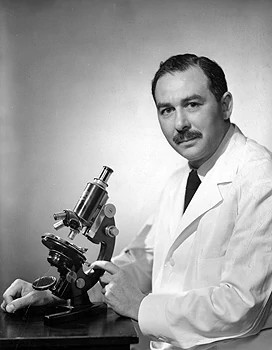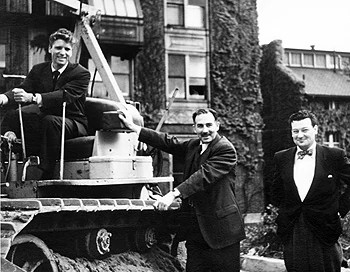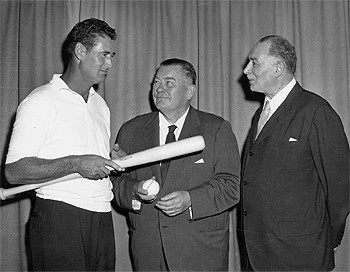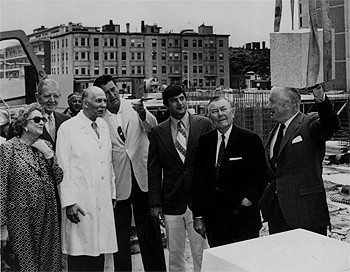Sidney Farber, MD
A Career in Cancer Research Driven by the Power of an Idea

The light seemed never to go out. At nine or ten o'clock at night, passersby on Binney Street would see it gleaming from the top floor of the Jimmy Fund Building and know that Sidney Farber, MD, was at work.
Associates didn't need to know whether the light in his office signified that Farber was reviewing the results of a clinical trial, preparing for an appearance before Congress, or discussing a new fundraiser with the Red Sox; there was never any doubt about the ultimate aim of his efforts.
He was convinced that the only thing standing between science and a cure for cancer was sustained research, sufficient funding, and the national will to bring it about.
It was a conviction he had a unique right to hold. At an age when other physicians and scientists were just settling into their careers, Farber had achieved the first clinical remission with chemotherapy ever reported for childhood leukemia.
In the mid-1940s, Farber was a pathologist at Boston's Children's Hospital. Medicine was poised for a post-war boom in research that would revolutionize the treatment of many diseases.
For children and adults with leukemia, however, the prognosis was as grim as it had been when the disease was first described in 1845: death, often painful, usually within weeks of diagnosis.
Leukemia was a symbol of medicine's longstanding powerlessness against many diseases. There was essentially nothing, other than a brief respite with cortisone therapy, that doctors could offer young leukemia patients.
Farber felt differently. Leukemia is a disease of the white blood cell-making tissue of the bone marrow. Studies during World War II had shown that pernicious anemia and tropical anemia – both caused when bone marrow fills with immature cells called blasts – could be cured relatively easily with vitamin B12 and folic acid, respectively.
Farber believed a similar solution could be achieved for leukemia. He knew that folic acid stimulates the growth and maturation of bone marrow. If a drug could be found that chemically blocks folic acid, he reasoned, it would shut down the production of the abnormal marrow associated with leukemia.
As luck would have it, the pharmaceutical manufacturer Lederle was testing just such a drug, called Aminopterin. In November 1947, Farber tried the drug on a group of 16 children who were seriously ill with leukemia. Temporary remissions were achieved in 10 of them.
Farber reported these results in the June 3, 1948, issue of the New England Journal of Medicine. Instead of acclaim and acceptance, however, many in the scientific community reacted to the news with a mixture of disbelief and resistance.
Part of the reason was cultural. In the entire history of medicine, no drug had proved effective against non-solid tumors (those that involve bodily fluids such as blood or lymph).
Frustration was taken as a sign of futility. Part of the reason for the chilly reception, surely, was personal: for a young pathologist working in a basement lab to make a discovery of such magnitude, with little in the way of funds, staff or scientific equipment, was seen as presumptuous.
The reaction among practicing physicians and pediatricians, however, was quite different. Calls, telegrams, and letters poured in from practitioners throughout New England and, later, around the country, asking for help or advice. Farber answered each one personally.
The discovery marked the first (but hardly the last) time Farber would overturn conventional medical wisdom or spearhead an advance against cancer.
Sidney Farber was born in 1903 in Buffalo, N.Y., the third oldest of 14 children. He graduated from the University of Buffalo in 1923 and took his first year of medical school at the Universities of Heidelberg and Freiberg, in Germany. He entered Harvard Medical School as a second-year student, graduating with the class of 1927.
After graduate training in pathology at Peter Bent Brigham Hospital in Boston (the predecessor of Brigham and Women's Hospital), he was appointed resident pathologist at Children's Hospital and assistant in pathology at Harvard Medical School in 1928. In 1929, he became the first full-time pathologist at Children's Hospital.
The publication of Farber's groundbreaking New England Journal study came at a propitious moment. World War II had recently ended, and the leaders of the motion picture industry were flush with wealth, as movie-making had been one of the few highly profitable industries during the war years.
How It Began

When leaders of the Variety Club of New England – a charitable organization formed by members of the entertainment community – sought a local scientist whose work offered a promising venue for financial support, they were directed to Farber.
The club established the Children's Cancer Research Foundation and began funding Farber's small outpatient clinic at Children's Hospital. The foundation's "defining moment" came on the evening of May 22, 1948, when the radio program "Truth or Consequences" introduced the nation to a young cancer patient who was being treated at the clinic.
(Farber, determined to protect his young patients from exploitation, insisted that the boy be known only as "Jimmy.")
The broadcast netted nearly a quarter of a million dollars for the Variety Club of New England Children's Cancer Research Foundation, which was renamed the Jimmy Fund.
Those and other contributions supported the construction of the four-story Jimmy Fund Building, which opened in 1952 at a cost of $1.47 million. What would later become the Sidney Farber Cancer Institute had a state-of-the-art home for laboratories, offices, and the newly created Jimmy Fund Clinic.
The entire Institute staff in those early years numbered a few hundred. Farber was a dignified man of formal, confident bearing, who had a grandfatherly gentleness with children.
Colleagues described a figure with a subtle, sometimes sly sense of humor, an immense capacity for work, and an ability to shift from imposing to cajoling to confiding as the situation demanded.
At more than six feet tall, impeccably dressed in custom-made suits with four-button vests, Farber was very visibly in command of the Institute. Though American through and through, he conveyed a sense of European stateliness: When he walked into a room, whether to deliver a lecture at Harvard Medical School or confer with colleagues, those in attendance would stand. He never demanded such a show of respect; his manner made it implicit.
Farber's formality did not distance him from the staff, every one of whom he knew by name. "Dr. Farber created an aura about him, but a kindly one," said Antoinette Pieroni, who was the Institute's first full-time social worker. "He didn't call people by their first names – I was always Miss Pieroni – and he spoke very deliberately. He had a very dry sense of humor, too."
Farber the Innovator

In many respects, Farber was far ahead of his time. Pieroni recalled that when she was hired, Farber told her she was to make rounds with the medical staff every morning and see every new patient in the clinic. Such regular contact between patient and social worker was unheard-of at the time. Today, it is virtually a universal practice.
In clinical care, one of Farber's innovations sounds as if it could have come out of today's headlines.
"He came up with the idea of what is now called 'total care,'" said former Institute President David G. Nathan, MD, who began working with Farber at Children's Hospital in the early 1960s. "He decided that all services for the patient and family – clinical care, nutrition, social work, counseling – should be provided in one place. All decisions should be made as a team. Everyone involved in care giving should plan the treatment together."
That such an idea should have been conceived by a pathologist – a physician not formally trained in clinical care – only made it more unlikely, not less revolutionary.
In the mid-1950s, he persuaded Children's Hospital to give him an entire inpatient floor on which to put his principles into practice. The hospital agreed, and it has become the model for pediatric cancer care around the world.
Throughout the 1950s and '60s, Farber continued to make advances in cancer research, notably the 1955 discovery that the antibiotic actinomycin D and radiation therapy could produce remission in Wilms' tumor, a pediatric cancer of the kidneys. And it was during this period that he took his persuasive powers to a national stage.
Beginning in the early 1950s, and continuing until his death in 1973, Farber became a star presenter at Congressional hearings on appropriations for cancer research. Animated, with a flair for the dramatic anecdote and poignant case history, Farber made a compelling speaker. He was not given to understatement or half-hearted vagueness.
"He would tell the senators and representatives that a new treatment looks so promising that an investment of federal support was crucial to bringing down the death rate from cancer," said Emil Frei III, MD, who became Institute director upon Farber's death.

"He was a medical diplomat," according to Farber's brother Darwin. "He saw that if cancer was going to be conquered, it would require a concerted national effort and a major funding commitment by Congress."
He was startlingly successful. With Mary Woodard Lasker, a longtime advocate of biomedical research, famed surgeon Michael DeBakey, Senator Lister Hill of Alabama and Congressman John Fogarty of Rhode Island, Farber led a massive expansion in federal spending for cancer research.
Between 1957 and 1967, the annual budget of the National Cancer Institute, the government's primary funder of cancer research, jumped from $48 million to $176 million.
Meanwhile, Farber was working to expand the Institute's clinical services to adults. "Dr. Farber would say that, in cancer, the child is the father to the man," Frei remarked. "Progress in cancer research at the clinical level almost always occurs in pediatrics first. Many of the treatments we now have for adults are based on what we learned with pediatric patients."
In 1969, the Institute's charter was expanded to provide services to patients of all ages. Farber was unsuccessful in his effort to recreate at Brigham and Women's Hospital an adult version of the cancer inpatient unit he'd built at Children's Hospital, so he opened one at the Institute itself. (Dana-Farber's inpatient beds moved to Brigham and Women's Hospital in 1997.)
Farber was always reluctant to forecast a date by which cancer would be cured. "Any man who predicts a date for discovery is no longer a scientist," he said in a 1971 newspaper article. "We have a solid basis of accomplishment in research and treatment to permit controlled optimism and expectation of rapid progress."
His carefully chosen words belie the fact that the "cure date," whenever it comes, was brought immeasurably closer by the accomplishments he made.
High School Student Inspired By Sidney Farber Research
The research breakthroughs of Dana-Farber’s founder, Sidney Farber, 75 years ago still make an impact, and have helped inspire a young person’s future. Read about Ananya Jain, the California high school student who chose Sidney Farber as the subject for her school's National History Day project. Inspired by Farber's work, Ananya now plans to pursue a medical career.